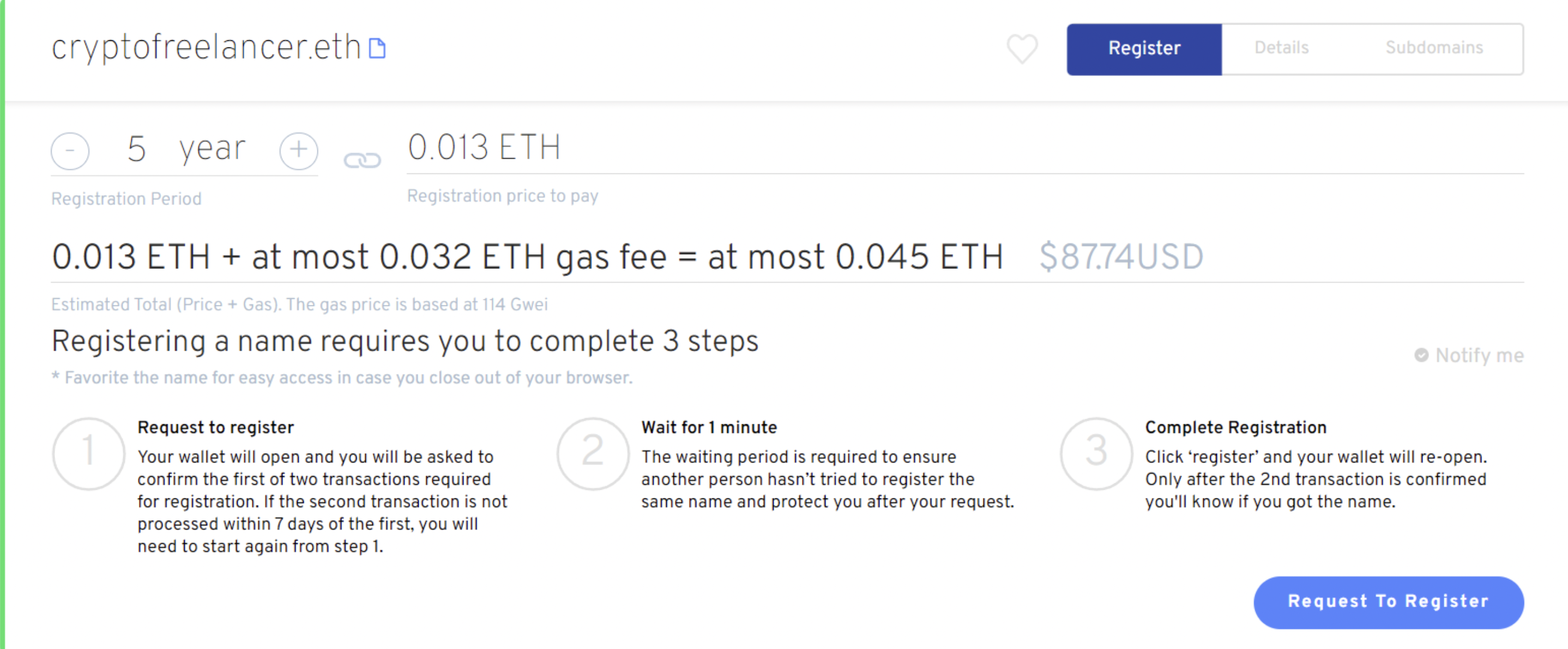
Embracing Change: HR in the World of Digital Assets
Hotcoin’s HR shares her journey from traditional industries to the world of Web3 and crypto, highlighting key insights on thriving in this space.
Read
The Ethereum Name Service (ENS) is a system that maps Ethereum addresses to a human-readable name, represented by an NFT. It’s also possible to link website URLs, crypto addresses on other chains, and additional information to an ENS record.
Ethereum addresses are long strings of hexadecimal characters that are generated from private keys and are used to receive ETH and tokens. While addresses are machine-readable and readily usable by wallets and decentralised applications (dApps), they are not intuitively recognisable or memorable for users.
The Ethereum Name Service (ENS) is a system that maps Ethereum addresses to a human-readable name, represented by an NFT. It’s also possible to link website URLs, crypto addresses on other chains, and additional information to an ENS record.
Adoption of ENS has soared in recent months, driven not only by the convenience of being able to replace a complicated address with a simple name, but also by wider interest in NFTs. In the crypto world there are bragging rights to owning short or unusual ENS names. The airdrop of ENS governance tokens in November 2021 further increased interest, and over 1 million names have been recorded on ENS to date.
Introduction To ENS
The Ethereum Name Service works in a similar way to how the internet’s Domain Name System (DNS) maps simple and memorable domain names to IP addresses, allowing web users to replace strings of numbers with names like “Chrono.Tech” or “TimeX.io”. Using ENS, for example, the name “vitalik.eth” can be used in supporting wallets and other DeFi services, instead of the corresponding Ethereum address, “0xd8dA6BF26964aF9D7eEd9e03E53415D37aA96045”.
The main advantage of this system is user friendliness. It’s practically impossible for users to remember their own Ethereum address, let alone other users’ addresses, and these therefore need copying and pasting when required. This can lead to mistakes being made, with funds potentially being sent to the wrong address.
Users can purchase, or more accurately rent, ENS names to use in place of their Ethereum addresses. This allows other users to send funds using a name like “laborx.eth” rather than “0x288DeF8225b9E150dc8789e5291CfC5c7E35Eb35”. Various information besides an address can be linked to an ENS record. For example, when used with a supporting browser like Brave, ENS names can also be used to access websites linked to the record (“laborx.eth” redirects to LaborX.com).
ENS domain names all end in .eth, and are represented by non-fungible tokens (NFTs) – unique, indivisible blockchain tokens that are also used to signify ownership of digital art, in-game items, and other one-off digital assets. As another form of digital property, recorded on the blockchain, ENS names can be traded on secondary markets like OpenSea, with rare names selling for many thousands of dollars. In April 2022, a collector paid 55.5 ETH, or over $160,000, for the ENS record “555.eth”.
How To Acquire An ENS Domain
The ‘.eth’ suffix is a ‘top-level domain’ (TLD), similar to a TLD like ‘.com’ or ‘.org’ on the internet. This is controlled by a registrar smart contract that allows users to create sub-domains like ‘laborx.eth’.
Users don’t buy ENS names outright. Instead, they rent them for a period of time. Eventually, if not renewed, the lease will expire and other users will be able to rent the record. The cost of renting an ENS name depends on how long the record is, with shorter names being more valuable, and how long the user wants to rent it for. (This helps to discourage squatting on high-value names, since there is always a cost to securing rights to an ENS record.) Three-character names cost $640 per year, four-character names $160 per year, and five-character names or longer just $5 per year.
To rent an ENS name, visit app.ens.domains and first check whether the name is available using the search function. You’ll see whether the record already exists, and if it does, when it is due to expire.


When you find a name that’s free, renting it is a two-stage process. You’ll need MetaMask and some ETH in your wallet. As you’ll see from the example below, the cost of renting a longer name for several years is still less than the gas costs paid.

The first stage is to request to register a name. After a short wait, which ensures two users don’t try to reserve the same name at the same time, you’ll be able to complete the registration.
Functionality and Integrations
Once registered, you can add many different pieces of data to an ENS record. You can save other crypto addresses, point to a website, and even create further subdomains like ‘customer.laborx.eth’ and ‘freelancer.laborx.eth’. These can be assigned to other users. For example, it would be possible to have alice.laborx.eth and bob.laborx.eth.
ENS has over 500 integrations. It’s supported by dozens of wallets including MetaMask, Coinbase, Rainbow, Trust Wallet, and Argent, plus a huge number of popular dApps and Ethereum-based services including Uniswap, Etherscan, OpenSea, and Aave, as well as a number of browsers.
ENS Token
In November 2021, ENS airdropped ENS tokens to users who had registered names in the past. ENS is a governance token, and is used by the ENS DAO to vote for the future direction of the service. The airdrop claim period ended on 4 May 2022.
If you missed the airdrop, it is still possible to buy ENS tokens on exchanges like Uniswap. If you hold ENS, you can use the Delegates Dashboard to assign your tokens’ voting weight to a delegate, or to yourself if you want to act as a delegate. Delegates vote on governance proposals that cover the running and priorities for ENS.
Alternative Decentralised Naming Services
ENS is one of several similar initiatives that aims to make Ethereum more user-friendly, providing the ability to replace complicated blockchain addresses with human-readable names. Projects like Handshake, Decentraweb, and Unstoppable Domains offer other decentralised naming services.
While ENS focuses on providing relatively limited functionality, it was the earliest service of its kind on Ethereum and enjoys strong network effect, with a large number of integrations and hundreds of thousands of users.

Hotcoin’s HR shares her journey from traditional industries to the world of Web3 and crypto, highlighting key insights on thriving in this space.
Read
Discover how Web3 is reshaping HR practices with insights from a leading expert in the field.
Read
Discover Base's innovative L2 solution addressing scalability, security, and user experience challenges in crypto. Learn about Base Incubator by LaborX, fostering growth and innovation within the Base ecosystem.
Read